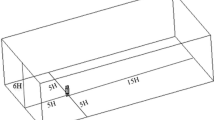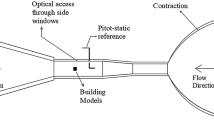Abstract
The geometry of a building is one of the influential parameters in calculating the wind load. This parameter is denoted as Cp in static methods. It is provided in codes for conventional buildings. The present study calculates the wind pressure coefficient for a non-conventional Y-shaped building model with a scale of 1:500. To obtain the wind effects on the building, the wind tunnel test and computational fluid dynamics (CFD) were employed. The model was rotated in 10-degree rotation steps within the wind tunnel to find the most critical wind load orientation. Also, the wind pressure was applied to the building in the CFD approach to obtain the maximum displacement. The largest displacement (relative to the original position at θ = 0°) was found to be 3.75 at θ = 30°. The numerical results were found to be in good agreement with the experimental wind tunnel results. This demonstrated that the proposed method could be a suitable alternative to the wind tunnel test.










Similar content being viewed by others
References
Canadian Commission on Building and Fire Codes. (1953). National Research Council Canada
Chen, Z., Li, H., Wang, X., Yu, X., & Xie, Z. (2019). Internal and external pressure and its non-Gaussian characteristics of long-span thin-walled domes. Thin-Walled Structures, 134, 428–441.
Cheng, C. M., & Fu, C. L. (2010). Characteristic of wind loads on a hemispherical dome in smooth flow and turbulent boundary layer flow. Journal of Wind Engineering and Industrial Aerodynamics, 98(6–7), 328–344.
Enajar, A., El Damatty, A., & Nassef, A. (2021). Semi-analytical solution for gable roofs under uplift wind loads. Engineering Structures, 227, 111420.
Fu, J. Y., Li, Q. S., & Xie, Z. N. (2006). Prediction of wind loads on a large flat roof using fuzzy neural networks. Engineering Structures, 28, 153–161.
Hu, W., Bohra, H., Azzuni, E., & Guzey, S. (2019). The uplift effect of bottom plate of aboveground storage tanks subjected to wind loading. Thin-Walled Structures, 144, 106241.
Kim, R. W., Lee, I. B., Yeo, U. H., & Lee, S. Y. (2019). Estimating the wind pressure coefficient for single-span greenhouses using an large eddy simulation turbulence model. Biosystems Engineering, 188, 114–135.
Kim, Y. C., Yoon, S. W., Cheon, D. J., & Song, J. Y. (2019). Characteristics of wind pressures on retractable dome roofs and external peak pressure coefficients for cladding design. Journal of Wind Engineering and Industrial Aerodynamics, 188, 294–307.
Kumar, K. S. (2020). Wind loading on tall buildings: Review of Indian Standards and recommended amendments. Journal of Wind Engineering and Industrial Aerodynamics, 204, 104240.
Kwon, K., Kim, D., Ha, T., & Lee, I. (2016). Evaluation of wind pressure coefficient of single-span greenhouses built on reclaimed coastal land using a large-sized wind tunnel. Bio Systems Engineering, 141, 58–81.
Li, F., Zou, L., Song, J., Liang, S., & Chen, Y. (2021). Investigation of the spatial coherence function of wind loads on lattice frame structures. Journal of Wind Engineering and Industrial Aerodynamics, 215, 104675.
Liu, H., Qu, W. L., & Li, Q. S. (2011). Comparison between wind load by wind tunnel test and in-site measurement of long-span spatial structure. Wind and Structures, 14(4), 301–319.
Qiu, Y., Sun, Y., Wu, Y., & Tamura, Y. (2014). Modelling the mean wind loads on cylindrical roofs with consideration of the Reynolds number effect in uniform flow with low turbulence. Wind Engineering and Industrial Aerodynamics, 129, 11–21.
Rizzo, F. (2012). Wind tunnel tests on hyperbolic paraboloid roofs with elliptical plane shapes. Engineering Structures, 45, 536–558.
Sadeghi, H., Heristchian, M., Aziminejad, A., & Nooshin, H. (2017). Wind effect on grooved and scallop domes. Engineering Structures, 148, 436–450.
Sadeghi, H., Heristchian, M., Aziminejad, A., & Nooshin, H. (2018). CFD simulation of hemispherical domes: Structural flexibility and interference factors. Asian Journal of Civil Engineering, 19(5), 535–551.
Sakib, F. A., Stathopoulos, T., & Bhowmick, A. K. (2021). A review of wind loads on canopies attached to walls of low-rise buildings. Engineering Structures, 230, 111656.
Shokrzadeh, A. R., & Sohrabi, M. R. (2016). Strengthening effect of spiral stairway on the buckling behavior metal tanks under wind and vacuum pressures. Thin-Walled Structures, 106, 437–447.
Thordal, M. S., Bennetsen, J. C., Capra, S., Kragh, A. K., & Koss, H. H. H. (2020). Towards a standard CFD setup for wind load assessment of high-rise buildings: Part 2–Blind test of chamfered and rounded corner high-rise buildings. Journal of Wind Engineering and Industrial Aerodynamics, 205, 104282.
Tian, Y., Guan, H., Shao, S., & Yang, Q. (2021). Provisions and comparison of Chinese wind load standard for roof components and cladding. Structures, 33, 2587–2598.
Vizotto, I., & Ferreira, A. M. (2015). Wind force coefficient on hexagonal free form shells. Engineering Structures, 83, 17–29.
Zhao, S., Yan, Z., & Savory, E. (2020). Design wind loads for transmission towers with cantilever cross-arms based on the inertial load method. Journal of Wind Engineering and Industrial Aerodynamics, 205, 104286.
Author information
Authors and Affiliations
Corresponding author
Additional information
Publisher's Note
Springer Nature remains neutral with regard to jurisdictional claims in published maps and institutional affiliations.
Rights and permissions
About this article
Cite this article
Rajabi, E., Sadeghi, H. & Hashemi, M.R. Wind effect on building with Y-shaped plan. Asian J Civ Eng 23, 141–151 (2022). https://doi.org/10.1007/s42107-022-00417-z
Received:
Accepted:
Published:
Issue Date:
DOI: https://doi.org/10.1007/s42107-022-00417-z




